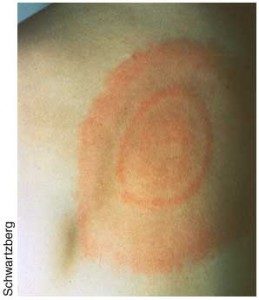Lyme Disease
Tick-Borne Lyme Disease Diagnosis and Treatment
Why all the worry about tick bites when we get bitten by other bugs (such as mosquitos) all the time? The concern is that many of the common tiny deer ticks (20%-60%) carry a type of bacteria called Borrelia burgdorferi. This little spirochete can be transferred during a feeding frenzy into our bloodstream from the tick. Deer and mice are also reservoirs of this bacteria, and the ticks pass the organism between them, and us.

What is Lyme Disease?
Borrelia burgdorferi was discovered (by Dr. Burgdorfer) to be the culprit of an illness causing inflamed joints in a cluster of children in Lyme, Connecticut in the 1970s. It soon became evident that males and females of any age could have the disorder. Lyme disease is most common in the Northeast U.S. from Maryland to Maine, but can also be seen more rarely in the Midwest, California, Oregon, and Europe. Approximately 25,000 cases per year are reported, primarily between May 1 and November 30, but the number is increasing every year. Many of our favorite summer spots such as Cape Cod and Nantucket have a high incidence of Lyme disease.
What are the Symptoms of Lyme Disease?
Most tick bites do not cause Lyme disease, either because the tick was not on long enough (it generally takes 48 hours to transfer the bacteria) because the tick was the larger “dog tick” which does not harbor the bacteria, or because there were no bacteria in the particular tick that fed. If, however, the B. burgdorferi bacteria does get into the bitten person’s bloodstream, a series of events occurs. Between 3 days to a few weeks after the bite, a spreading rash called “erythema migrans” occurs on the skin in about 50% of adults and 90% of children with Lyme. As you can see from the photo, this painless rash is generally not subtle. The lesion or lesions can be large (15 cm.) and are sometimes mistaken by a patient as a “spider bite” (real spider bites are extremely uncommon). The rash usually occurs in the location of the bite, though the bug is long gone. It can last anywhere from a day to a year, though a few weeks is most common. Unfortunately, many people with Lyme disease do not get this bullseye rash, and so are less likely to know they have Lyme disease.

With or without a rash, patients experience some flu-like symptoms, including muscle soreness and aches, fatigue, enlarged lymph nodes, headache, neck pain, fever and chills, and joint pain. These symptoms can last a few hours to months, and be constant or intermittent, and change over time. Fatigue is generally longer lasting than the other symptoms. A cluster of these signs during the summer in an area with a lot of Lyme disease and ticks, even without a rash, should be treated for Lyme disease.
About 15% of untreated patients develop problems with their nervous system within weeks to months of the flu-like illness. These can include symptoms of meningitis (head and neck pain, light sensitivity, headache), and Bell’s palsy (loss of movement on one side of the face) or nerve pain. This can last months but generally resolves completely. In addition, 8% of patients can develop problems with the heart, including electrical problems called arrhythmias which can be dangerous. Finally, 60% of untreated patients will get arthritis, often of the knee, in one or more joints with swelling and fatigue.
Now that we have scared you all, why don’t we just perform a blood test when someone is bitten by a tick? Unfortunately, the available tests are not extremely reliable, particularly in the early stage of the disease. It takes weeks for the tests to become positive, and even then not everyone who has Lyme disease, even with the classic enlarging bullseye rash of erythema migrans, has a positive result.
How Can I Treat and Prevent Lyme Disease?
So what to do? First of all, try to make sure you find ticks before they have been feasting on you for 2 days. Sounds easy, but it’s not. These ticks are very small at first and enlarge only when filled with your own blood. First instinct is to smash them or pull them out with anything you’ve got. But you need to take your time. Clean the area with the tick with alcohol or hand sanitizer. Take a pair of tweezers and get down to the very base of the bug almost below the surface of your skin, grab and pull it straight out. If you squeeze on the wider part of the bug, you may force more of its salivary juices into you, together with the Borrelia bacteria living in there.

Second, if you are able to take a single 200 mg dose of the antibiotic Doxycycline (if you are not allergic to it) within 3 days of finding a tick on yourself, this will reduce your chance of contracting Lyme disease from that bite by 50%. Some physicians don’t advocate this, as the risk of contracting Lyme from any single tick bite is low to begin with, but it may be helpful. Children under 8 years old cannot take Doxycycline as it can indefinitely stain their teeth. You do not need to be treated with a full course of antibiotics for each tick bite, but if you discover a tick, then days to weeks later get the symptoms discussed above, then you must get the full course of antibiotics to protect yourself from the more serious manifestations of Lyme disease. This full course is generally Doxycycline 100 mg twice per day for 2-3 weeks. Side effects include possible nausea, heartburn, allergic reaction and sun sensitivity. For children under 8 years old, pregnant women and patients that are allergic to Doxy or cannot tolerate its side effects, Amoxicillin can be used instead.
If you have the erythema migrans (EM) rash, see your primary care doctor or dermatologist right away to confirm and to start medication. If you get a cluster of flu-like symptoms including joint or muscle pains with or without the EM rash or a tick bite, discuss with your doctor to see if your illness fits Lyme disease, or another problem (such as Mono) and whether you should be tested for Lyme disease, or treated with antibiotics without the test.
To help prevent Lyme in the first place, use a DEET containing insect repellent when spending time in the woods or other outdoor areas. Spray the outside of your clothing including shoes, hats and outerwear with Permethrin spray (lasts through multiple washes). Check yourself and your kids from head (and scalp) to toe for ticks after spending time outside, gardening, running in the woods, etc.. Keep your dogs and outdoor cats out of your bed! See your doctor if you have unusual joint pains, or a large reddish skin lesion or lesions, or other symptoms mentioned during the late spring, summer or early fall. There is no vaccine commercially available to prevent Lyme disease. Ah, the joys of the outdoors. And don’t forget your sunscreen too!

